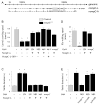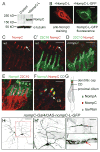The role of the TRP channel NompC in Drosophila larval and adult locomotion
- PMID: 20696376
- PMCID: PMC2933178
- DOI: 10.1016/j.neuron.2010.07.004
The role of the TRP channel NompC in Drosophila larval and adult locomotion
Abstract
The generation of coordinated body movements relies on sensory feedback from mechanosensitive proprioceptors. We have found that the proper function of NompC, a putative mechanosensitive TRP channel, is not only required for fly locomotion, but also crucial for larval crawling. Calcium imaging revealed that NompC is required for the activation of two subtypes of sensory neurons during peristaltic muscle contractions. Having isolated a full-length nompC cDNA with a protein coding sequence larger than previously predicted, we demonstrate its function by rescuing locomotion defects in nompC mutants, and further show that antibodies against the extended C terminus recognize NompC in chordotonal ciliary tips. Moreover, we show that the ankyrin repeats in NompC are required for proper localization and function of NompC in vivo and are required for association of NompC with microtubules. Taken together, our findings suggest that NompC mediates proprioception in locomotion and support its role as a mechanosensitive channel.
(c) 2010 Elsevier Inc. All rights reserved.
Figures





Comment in
-
The force be with you: a mechanoreceptor channel in proprioception and touch.Neuron. 2010 Aug 12;67(3):349-51. doi: 10.1016/j.neuron.2010.07.022. Neuron. 2010. PMID: 20696370
-
Proprioception: Sensational mechanics.Nat Rev Neurosci. 2010 Oct;11(10):665. doi: 10.1038/nrn2922. Nat Rev Neurosci. 2010. PMID: 21080532 No abstract available.
References
-
- Ainsley JA, Pettus JM, Bosenko D, Gerstein CE, Zinkevich N, Anderson MG, Adams CM, Welsh MJ, Johnson WA. Enhanced locomotion caused by loss of the Drosophila DEG/ENaC protein Pickpocket1. Curr Biol. 2003;13:1557–1563. - PubMed
-
- Albert JT, Nadrowski B, Gopfert MC. Mechanical signatures of transducer gating in the Drosophila ear. Curr Biol. 2007;17:1000–1006. - PubMed
-
- Bodmer R, Jan YL. Morphological differentiation of the embryonic peripheral neurons in Drosophila. Roux’s Archives of Developmental Biology. 1987;196:69–77. - PubMed
-
- Chung YD, Zhu J, Han Y, Kernan MJ. nompA encodes a PNS-specific, ZP domain protein required to connect mechanosensory dendrites to sensory structures. Neuron. 2001;29:415–428. - PubMed
-
- Ernstrom GG, Chalfie M. Genetics of sensory mechanotransduction. Annu Rev Genet. 2002;36:411–453. - PubMed
Publication types
MeSH terms
Substances
Associated data
- Actions
Grants and funding
LinkOut - more resources
Full Text Sources
Other Literature Sources
Molecular Biology Databases

